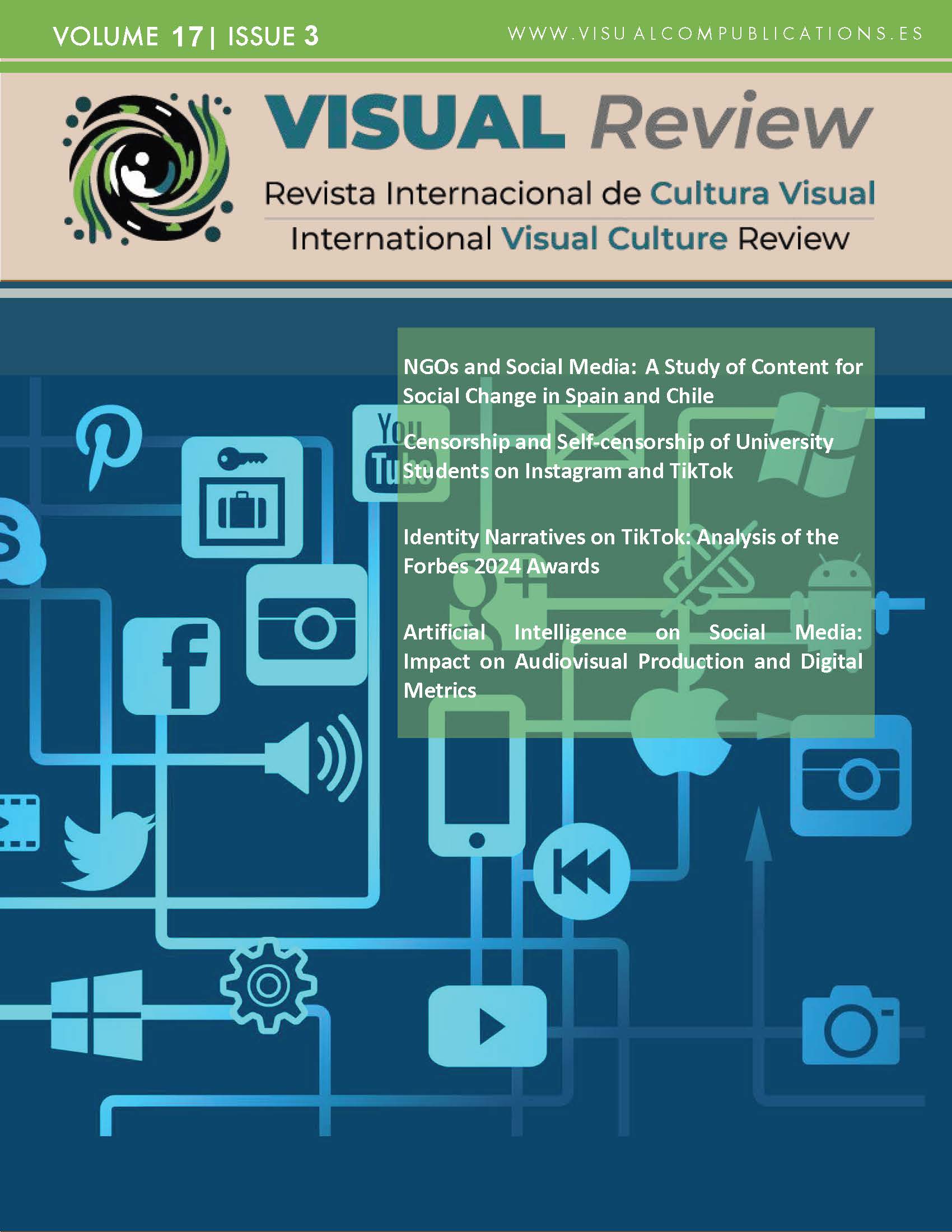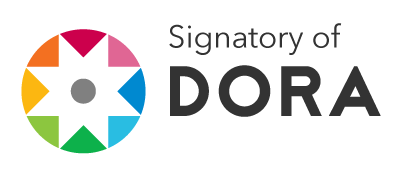Identity Narratives on TikTok
Analysis of the Forbes 2024 Awards
DOI:
https://doi.org/10.62161/revvisual.v17.5790Keywords:
Social Media, TikTok, Influencers, Communication, Identity, Trends, ForbesAbstract
The research examines the influence exerted by TikTokers featured in the Forbes 2024 list on the construction of individual and collective identities in cyberspace. Using a purposefully developed rubric, the research seeks to qualitatively explore the self-representation strategies and performative practices of the nominated profiles (n=34). The findings reveal how these practices shape discourses, generate trends, reinforce stereotypes, and configure aspirations that affect audiences. In addition, the conclusions emphasize the role of content creators in shaping digital narratives, highlighting the complex interactions between individual influence –along with social impact– and the construction of personal brand.
Downloads
Global Statistics ℹ️
|
605
Views
|
575
Downloads
|
|
1180
Total
|
|
References
Andonopoulos, V. (2021). Authentic, but make it personal: an examination of social media influencer personal authenticity. [Doctoral thesis] The University of New South Wales. Electronic Thesis and Dissertation Repository. https://doi.org/10.26190/unsworks/2339
Arriagada, A., & Bishop, S. (2021). Between commerciality and authenticity: The imaginary of social media influencers in the platform economy. Communication, Culture and Critique, 14(4), 568-586. https://doi.org/10.1093/ccc/tcab050
Arriagada, A., & Ibáñez, F. (2020). “You need at least one picture daily, if not, you’re dead”: content creators and platform evolution in the social media ecology. Social Media + Society, 6(3). https://doi.org/10.1177/2056305120944624
Ayala, T. (2014). Redes sociales, poder y participación ciudadana. Revista Austral de Ciencias Sociales, (26), 23-48.
Baym, N. K. (2015). Personal connections in the digital age. John Wiley & Sons.
Bertoni, S. (2024). Los 10 creadores de contenidos que más cobran del mundo. Forbes. https://forbes.es/listas/528903/10-content-creators-mas-cobran/
Brooks, G., Drenten, J., & Piskorski, M. J. (2021). Influencer celebrification: How social media influencers acquire celebrity capital. Journal of advertising, 50(5), 528-547. https://doi.org/10.1080/00913367.2021.1977737
Butler, J. (1990). Gender Trouble: Feminism and the Subversion of Identity. Routledge.
Butler, J. (1993). Bodies That Matter: On the Discursive Limits of Sex. Routledge.
Castañeda, V. G. G. (2019). Estética del sujeto hipermediatizado: Edición, estilización y curaduría del yo en la red. ASRI: Arte y sociedad. Revista de investigación, (17), 12-24.
Chaffey, D. (2023). Global Social Media Statistic Research Summary 2023 [Blog]. Smart Insights. https://bit.ly/4h34ktx
Cheung, M. L., Leung, W. K., Aw, E. C. X., & Koay, K. Y. (2022). “I follow what you post!”: the role of social media influencers’ content characteristics in consumers' online brand-related activities (COBRAs). Journal of Retailing and Consumer Services, 66, 102940. https://doi.org/10.1016/j.jretconser.2022.102940
Cotter, K. (2019). Playing the visibility game: How digital influencers and algorithms negotiate influence on Instagram. New media & society, 21(4), 895-913. https://doi.org/10.1177/1461444818815684
Dorofeeva, M., & Öze, N. (2023). Instagram’s Influence on Self-representation of Young Users. Akdeniz Üniversitesi İletişim Fakültesi Dergisi, (43), 1-18. https://doi.org/10.31123/akil.1352954
Dueñas, P. P. M., & Simancas-González, E. (2024). Análisis sobre la eficacia del influencer marketing en el mundo de la moda. European Public & Social Innovation Review, 9, 1-15. https://doi.org/10.31637/epsir-2024-340
Elorriaga Illera, A., & Monge Benito, S. (2018). La profesionalización de los youtubers: el caso de Verdeliss y las marcas. Revista latina de comunicación social, 73, 37-54. https://doi.org/10.4185/RLCS-2018-1244
Enke, N., & Borchers, N. S. (2021). Social media influencers in strategic communication: A conceptual framework for strategic social media influencer communication. In N. S. Borchers (Ed.), Social media influencers in strategic communication (pp. 7-23). Routledge. https://doi.org/10.4324/9781003181286
Faltesek, D., Graalum, E., Breving, B., Knudsen, E., Lucas, J., Young, S., & Varas Zambrano, F. E. (2023). TikTok as television. Social Media+ Society, 9(3), 1-13. https://doi.org/10.1177/20563051231194576
Felix, A., Bernanda, D. Y., Rembulan, G. D., Giovanno, N., & Muti, R. N. (2024, August). Micro influencers enhancing brand visibility and audience engagement on tiktok digital platform. In 2024 3rd International Conference on Creative Communication and Innovative Technology (ICCIT) (pp. 1-7). IEEE. https://doi.org/10.1109/ICCIT62134.2024.10701155
Fisher, E., & Mehozay, Y. (2019). How algorithms see their audience: Media epistemes and the changing conception of the individual. Media, Culture & Society, 41(8), 1176-1191. https://doi.org/10.1177/0163443719831598
Goffman, E. (1959). The Presentation of Self in Everyday Life. Anchor Books.
Haenlein, M., Anadol, E., Farnsworth, T., Hugo, H., Hunichen, J., & Welte, D. (2020). Navigating the new era of influencer marketing: How to be successful on Instagram, TikTok, & Co. California management review, 63(1), 5-25. https://doi.org/10.1177/0008125620958166
Hania, R., & Souad, O. (2024). Social Media Influencers and the Fabrication of Social Reality through Digital Platforms: Analyzing Jean Baudrillard's Viewpoint. Aleph, 11(5), 27-49. https://aleph.edinum.org/12887
Jacobson, J. (2020). You are a brand: social media managers’ personal branding and “the future audience”. Journal of Product & Brand Management, 29(6), 715-727. http://dx.doi.org/10.1108/JPBM-03-2019-2299
Jenkins, H., Ford, S., & Green, J. (2015). Spreadable media: Creating value and meaning in a networked culture. NYU Press.
Jordan, J. M. (2024). The Rise of the Algorithms: How YouTube and TikTok Conquered the World. Penn State Press.
Kavada, A. (2020). Creating the collective: social media, the Occupy Movement and its constitution as a collective actor. In A. Karatzogianni, M. Schandorf & I. Ferra (Eds.), Protest technologies and media revolutions (pp. 107-125). Emerald Publishing Limited.
Kaye, D. B. V., Zeng, J., & Wikstrom, P. (2022). TikTok: Creativity and culture in short video. John Wiley & Sons.
Kepios (2024). Global Digital Report. Kepios. https://kepios.com/reports
Khan-Dobson, D. (2021). “The Real Me is the Fake Me:” Applying Knowledge of the Social Sciences to Narrative Journalism to Tell Complex Stories in the Format of a Long Form Magazine Article. [Doctoral tesis]. Concordia University.
Kim, J., Kim, M., & Lee, S. M. (2024). Unlocking Trust Dynamics: An Exploration of Playfulness, Expertise, and Consumer Behavior in Virtual Influencer Marketing. International Journal of Human–Computer Interaction, 1-13. https://doi.org/10.1080/10447318.2023.2300018
Kułaga, W. (2024). Revolutionizing Visual Communication and Digital Creative Engagement: The Game-Changing Impact of TikTok. Przegląd Socjologii Jakościowej, 20(3), 212-235.
Laso, L. (2022). La comunicación al poder. Manual para rescatar la democracia. Ediciones Morata.
Leonardi, P. M. (2014). Social media, knowledge sharing, and innovation: Toward a theory of communication visibility. Information systems research, 25(4), 796-816. https://doi.org/10.1287/isre.2014.0536
Maares, P., Banjac, S., & Hanusch, F. (2021). The labour of visual authenticity on social media: Exploring producers’ and audiences’ perceptions on Instagram. Poetics, 84, 101502. https://doi.org/10.1016/j.poetic.2020.101502
Mardon, R., Cocker, H., & Daunt, K. (2023). How social media influencers impact consumer collectives: An embeddedness perspective. Journal of Consumer Research, 50(3), 617-644. https://doi.org/10.1093/jcr/ucad003
Márquez, I., & Ardévol, E. (2018). Hegemonía y contrahegemonía en el fenómeno youtuber. Desacatos, (56), 34-49. https://bit.ly/4amIFu5
Mateus, J. C., Leon, L., & Núñez-Alberca, A. (2022). Influencers peruanos, ciudadanía mediática y su rol social en el contexto del COVID-19. Comunicación y sociedad, 19, 1-25. https://doi.org/10.32870/cys.v2022.8218
Mera-Plaza, C. L., Cedeño-Palacios, C. A., Mendoza-Fernandez, V. M., & Moreira-Choez, J. S. (2022). El marketing digital y las redes sociales para el posicionamiento de las PYMES y el emprendimiento empresarial. Revista Espacios, 43(03), 27-34. https://doi.org/10.48082/espacios-a22v43n03p03
Pedroni, M. (2023). Two decades of fashion blogging and influencing: A critical overview. Fashion Theory, 27(2), 237-268. https://doi.org/10.1080/1362704X.2021.2017213
Perdana, A., & Bharathi, S. V. (2023). Bytedance’s global rise: An exemplar of strategic adaptability and digital innovation in a global context. Journal of Information Technology Teaching Cases, 1-10. https://doi.org/10.1177/20438869231211598
Pérez-Escoda, A., Jiménez-Narros, C., Perlado-Lamo-de-Espinosa, M., & Pedrero-Esteban, L. M. (2020). Social networks’ engagement during the COVID-19 pandemic in Spain: Health media vs. healthcare professionals. International journal of environmental research and public health, 17(14), 5261. https://doi.org/10.3390/ijerph17145261
Santolaya Calvo, S. (2024). La nueva era digital: análisis de Tiktok como estrategia publicitaria. [Degree thesis]. Universidad de Valladolid. Electronic Thesis and Dissertation Repository. https://uvadoc.uva.es/handle/10324/70761
Sedda, P., & Husson, O. (2023). Social Media Influencers: A New Hybrid Professionalism in the Age of Platform Capitalism?. In L. Maestripieri & A. Bellini (Eds.), Professionalism and Social Change: Processes of Differentiation Within, Between and Beyond Professions (pp. 281-304). Palgrave Macmillan. https://doi.org/10.1007/978-3-031-31278-6_13
Singh, S. (2025). How Many People Use TikTok 2025 (Users Statistics). DemandSage. https://bit.ly/3CthrFn
Stein, K. (2024). And How Does That Make You Feel?: Unpacking the Phenomenon of TikTok. [Doctoral thesis]. University of Illinois at Chicago. Electronic Thesis and Dissertation Repository. https://bit.ly/4h3Rk73
Taylor, A. S. (2022). Authenticity as performativity on social media. Springer Nature.
Tirocchi, S. (2024). Generation Z, values, and media: from influencers to BeReal, between visibility and authenticity. Frontiers in sociology, 8. https://doi.org/10.3389/fsoc.2023.1304093
Torres-Toukoumidis, Á., De-Santis, A., & Vintimilla-León, D. (2021). TikTok: más allá de la hipermedialidad. Editorial Abya-Yala.
Treem, J. W., & Leonardi, P. M. (2013). Social media use in organizations: Exploring the affordances of visibility, editability, persistence, and association. Annals of the International Communication Association, 36(1), 143-189. https://doi.org/10.1080/23808985.2013.11679130
Vrontis, D., Makrides, A., Christofi, M., & Thrassou, A. (2021). Social media influencer marketing: A systematic review, integrative framework and future research agenda. International Journal of Consumer Studies, 45(4), 617-644.
Wang, F., & Carlson, B. D. (2024). Self-disclosure of content creators: A systematic review and holistic framework. AMS Review, 1-19. https://doi.org/10.1007/s13162-024-00290-w
Woolley, S. C. (2022). Digital propaganda: The power of influencers. Journal of Democracy, 33(3), 115-129. https://dx.doi.org/10.1353/jod.2022.0027
Zuccherino, S. (2021). Social Media Marketing: la revolución de los negocios y la comunicación digital. Editorial Temas.
Downloads
Published
How to Cite
Issue
Section
License
Copyright (c) 2025 Authors retain copyright and transfer to the journal the right of first publication and publishing rights

This work is licensed under a Creative Commons Attribution-NoDerivatives 4.0 International License.
Those authors who publish in this journal accept the following terms:
-
Authors retain copyright.
-
Authors transfer to the journal the right of first publication. The journal also owns the publishing rights.
-
All published contents are governed by an Attribution-NoDerivatives 4.0 International License.
Access the informative version and legal text of the license. By virtue of this, third parties are allowed to use what is published as long as they mention the authorship of the work and the first publication in this journal. If you transform the material, you may not distribute the modified work. -
Authors may make other independent and additional contractual arrangements for non-exclusive distribution of the version of the article published in this journal (e.g., inclusion in an institutional repository or publication in a book) as long as they clearly indicate that the work was first published in this journal.
- Authors are allowed and recommended to publish their work on the Internet (for example on institutional and personal websites), following the publication of, and referencing the journal, as this could lead to constructive exchanges and a more extensive and quick circulation of published works (see The Effect of Open Access).













